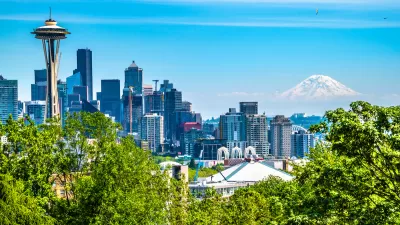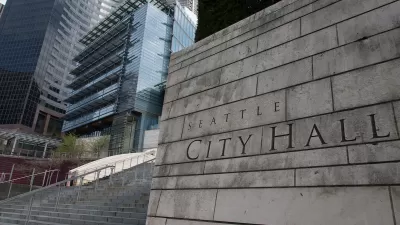Seattle trails international peer cities in its social housing stock, but there are steps city leaders can take to produce more units and increase affordability.

Doug Trumm reports on Seattle's limited progress in creating more social housing, defined as "several forms of affordable housing including public housing, nonprofit housing, and rent-restricted homes in market-rate buildings offered via incentive programs like inclusionary zoning." Trumm points to peer cities around the world where social housing is a major part of housing policy. Singapore's social housing comprises 80% of housing stock; in Vienna, that number is 60%. Famously expensive Paris is on track to have 30% social housing by 2030. In Seattle, social housing comprises just 8.6% of housing stock, a number not projected to increase much.
Building more social housing, Trumm argues, " would combat displacement and shrink commutes for working class people, who keep the city functioning and culturally vibrant," and "engender mixed-income neighborhoods rather than Seattle slipping into a one-class city of the rich." This sentiment is echoed by Paris mayor Anne Hidalgo, whose statement that "everyone should have the possibility to live in Paris" has guided city policy during her administration.
According to Trumm, Seattle has the opportunity to build more social housing through the Seattle Housing Levy, the city's Mandatory Housing Affordability (MHA) program, and a variety of tax programs aimed at promoting housing density and producing revenue for housing projects. "The benefits of social housing are significant and setting an ambitious social housing target isn’t about bragging rights. It’s about making Seattle a better city and increasing quality of life for all people, not just the rich." Once freed from excessive rent burdens, Trumm writes, "working class folks would pump money into the economy, invest in education, business ventures, cultural creation, and their personal wellbeing."
FULL STORY: Growing Social Housing in Seattle

Study: Maui’s Plan to Convert Vacation Rentals to Long-Term Housing Could Cause Nearly $1 Billion Economic Loss
The plan would reduce visitor accommodation by 25,% resulting in 1,900 jobs lost.

North Texas Transit Leaders Tout Benefits of TOD for Growing Region
At a summit focused on transit-oriented development, policymakers discussed how North Texas’ expanded light rail system can serve as a tool for economic growth.

Why Should We Subsidize Public Transportation?
Many public transit agencies face financial stress due to rising costs, declining fare revenue, and declining subsidies. Transit advocates must provide a strong business case for increasing public transit funding.

How Community Science Connects People, Parks, and Biodiversity
Community science engages people of all backgrounds in documenting local biodiversity, strengthening connections to nature, and contributing to global efforts like the City Nature Challenge to build a more inclusive and resilient future.

Alabama: Trump Terminates Settlements for Black Communities Harmed By Raw Sewage
Trump deemed the landmark civil rights agreement “illegal DEI and environmental justice policy.”

Dear Tesla Driver: “It’s not You, It’s Him.”
Amidst a booming bumper sticker industry, one writer offers solace to those asking, “Does this car make me look fascist?”
Urban Design for Planners 1: Software Tools
This six-course series explores essential urban design concepts using open source software and equips planners with the tools they need to participate fully in the urban design process.
Planning for Universal Design
Learn the tools for implementing Universal Design in planning regulations.
City of Santa Clarita
Ascent Environmental
Institute for Housing and Urban Development Studies (IHS)
City of Grandview
Harvard GSD Executive Education
Toledo-Lucas County Plan Commissions
Salt Lake City
NYU Wagner Graduate School of Public Service





























